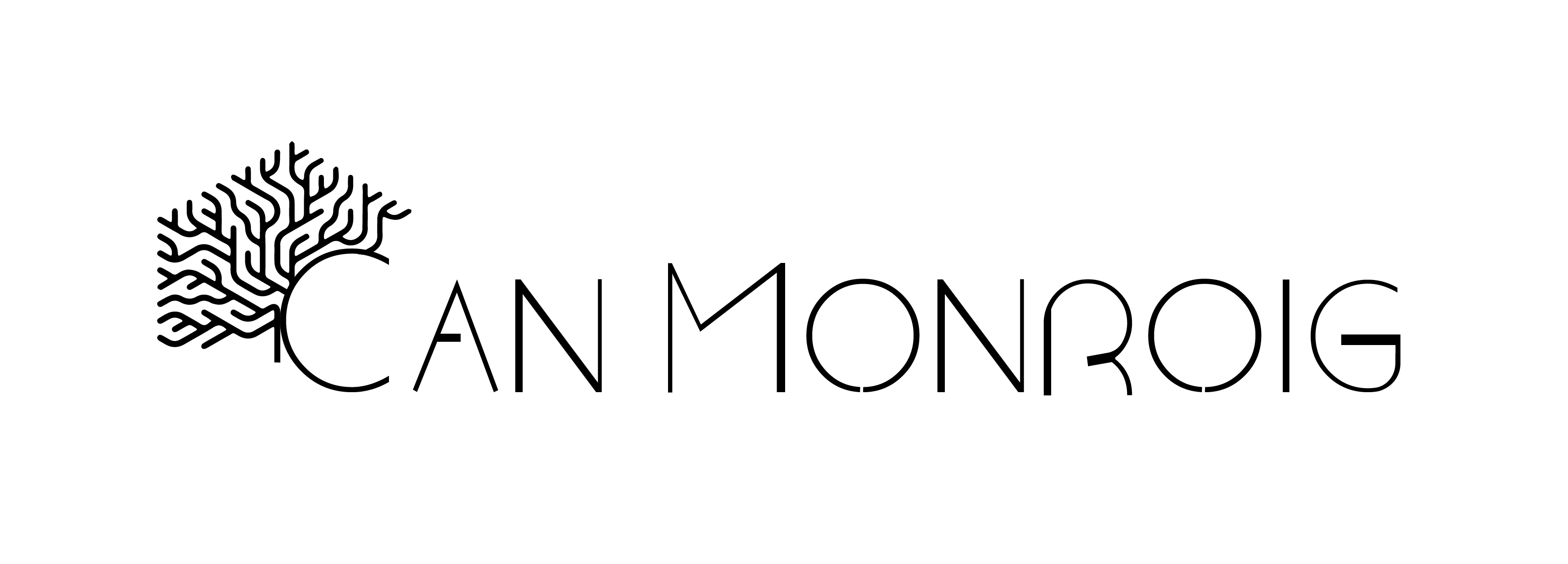
Can Monroig and the call of Inca
The Can Monroig house, which is located at number 22 on Can Valella street, has also been connected to the name of Can Móra. This building is located in Call d'Inca, the neighborhood that was formed by the numbers of cases configured for the streets of Sant Francesc, la Virtut, Can Valella, Pare Cerdà, Call i la Rosa.
The current house with two floors and dating from the 16th century, presents a façana of walls decorated with stones, resembling the façana of Can Siquier. The openings are formed by various ends, with the exception of the entrance portal, which is finished with an arch of mig pointed dovellat of living stone like the lower part of that façana. Just like the previously mentioned Can Siquier, the interior has some remains from the Baroque period (ansa paner arches).
This house is in the middle of many years and in the midst of the storm it was bad, but it was bought by some of its owners and they were due to complete a great restoration that includes the light and many architectural elements. that may show the medieval heritage of the house.
The Gothic elements of the building that can be observed today are formatted by a series of arches, ogivals and mig points, and also some portals and some architraved walls. Here, the interior of the house is formatted by two crugies. In the first crugia there are three rooms perpendicular to the façana and separated by arches. This is what can be considered as the entrance to the house, on the left side there is a large arch from the baroque period and, next, a large ogival stone arch from the medieval period. On the right side there is a rounded and whitened arch that leads to a room to which a walled ogival arch also stands out.
ogival arch
The first crugia is separated from the second mitjançant by a wall in which there is an architectural portal with accesses between the two crugies and, on the second coast, a finished finestra with a mig punt arch that is possibly also potentially dated. of the medieval period due to the great appearance of the three portals and fine doors in Gothic buildings of the period (Palau de l'Almudaina, Palau dels Reis de Mallorca de Sineu, Torre dels Enagistes de Manacor, etc.). It is also not ruled out that at some point in time there may have been a portal.
Window
At the second crugia and in the esquerre wall there is a stone portal arched with a linda of whip, all followed by a square finestra and to finish a stone portal, it is arched, but that I originally designed finished with a mig arch punt, just like the one that is troba to the wall of separation between the two crugies. Due to its different shape and situation, we think it is also traced back to medieval remains.
At the back of the house, where the patio is located, on the left side there is an open space with a panoramic arch from the Baroque period, of which the lower part stands out, which we see in common. There was a previous one, also from ansa paner, and it faces in a more ancient way, which for the col·locació of the stones I meant to be pointed out. Furthermore, on the other hand, he confronts potentially the outburst of what seems to be the nerve of belief. On the part of the arcade, on the wall of the fons, the shape of the ogival arch is well marked, for the widened space, one might think that it is tractava of a space covered by two sections on both sides. of belief.
Pati
Once you discover these architectural remains that date back to the 14th century, where the house is located, it is easy to think that these are some Gothic remains that most probably date back to that century or the end of the 13th century.
In addition to these troballs, the restoration of the house foren aixecats all the trespols and is a series of very interesting troballs.
Cub
Així, it is worth noting that, on the right side of the entrance, there was an ancient forn that remained buried on each level of the street, as well as a series of cubes and stone compartments distributed throughout the house connected among them mitjançant canonades fetes de fang. Furthermore, it is known that the house also has a cellar and contains a cistern. There are also two seats on the patio, one larger than the other. In the small room, they discovered some steps that could be accessed and inside there was a bronze aixeta with anthropomorphic decoration (two ulls and one nauseous).
Forn
Unlike the architectural remains formed by the various arches, in the case of the troballes of the forn, the different chambers, cisterns and pouss, I do not dare to date them, since at the end they have not been studied archaeologically and, therefore, We do not have convincing information that allows us to know either who the victim was or how the forens were constructed. Furthermore, it should also be noted that Can Monroig is a house that has undergone several transformations and extensions over the centuries, which makes its study more difficult.
But, unfortunately, it is important to take into account some important facts that in the future, after a good archaeological study, could help to decipher these different troublings.
Here again, we must highlight that the house is located where in the 14th century the Call d'Inca was. For this reason, we believe it is necessary to note some bibliographic information about them. Thursdays in Mallorca, to Inca and about the erection of our call, without forgetting that of Ciutat de Mallorca.
The call of Inca
It is possible to trace the origins of the presence of Jueus in Mallorca in the 5th century, both in Mallorca and in Menorca, as it also documents a letter from the great Sever l'any 417. Also, thanks to various sources, we know that during the Islamic domination of the island (902-1229) there was also an important community of jueus. Així, when Jaume I conquered Mallorca in 1229, is now going to find an important community next to the city of Mallorca, but also in other parts of the Foreign Part such as Inca, Petra, Montuïri, Felanitx, Sineu, Alcúdia, Sóller and Pollença .
The Jueva d'Inca community appears documented in 1232, when Jaume I grants compensation to the Jueus d'Inca, from l'Almudaina de Gomara (Ciutat), from Petra and from Montuïri[1]. A document from 1240 confirms the presence of jueus a Inca. On the other hand, the Conqueridor donated his support to the jueus of Mallorca, granting royal protection, privileged that confirmed the king's mateix in 1247.
More documentation is available regarding the Jueva d'Inca community during the years that make up the 14th century. These facts are documented in the Morabatí books of the years 1329 and 1336. We also know that in these years the jueus inquers face not having a barri (call) to live all the folds, but rather that habitations are distributed in different indrets of the town . In contrast, it did have good organization under the institution known as the Aljama, which was approved by the king and had councillors, secretaries and attorneys, in addition to ensuring certain public independence.[2] .
In 1346, due to the important and constant confrontations between some of the members of the Jewish community and the Christian community, King Pere the Cerimoniós managed to issue a call for the Inquera village. Malgrat the royal decision because of the great decline of the population Thursday after the plague of 1348, it was not until 1372 when the call of Inca was definitively established, even in 1353 the jurats of Inca They have demanded from the governor that he is building a call and assigning a lloc located in the Sant Bartomeu neighborhood, specifically on Martí Metge street, but the lloc was not liked on Thursdays because of the poor state of the cases, moles in state of ruin, and appeal to the king for such that they grant another year to establish themselves. Finally, King Pere IV of Aragó, as we have seen previously, in 1372 granted a new land located on the name street of Pascolet, located in the Sant Francesc neighborhood.

Stone portal architrave
The Assault on the Call of 1391
The call d'Inca, resembling the Cas de Ciutat, was enclosed by a wall and tanned by two portals, one of which was probably located on Sant Francesc Street, as it consists of documents from 1372, on which it is claimed that a dels portals sia fet al carrer de Sant Francesc[3]. Damn all, that the jueus tenguessin their own neighborhood tancat of the rest of the vila is not enough to aturar the confrontations and assaults to the cases Thursday by part of the Christians, and at 1391 they assault the calls of Palma and d'Inca. The Christians dugueren a terme diferents avalots mitjançant those who perpetrate numerous acts of pillage and destruction, assassinate in a great name of jueus (the one that makes Inca, the documents speak of a quasi-total extermination) and focus on cases and botigues of the call , deixant raze the barri sencer.
Back to Can Monroig…
As a final conclusion and have not located the Can Monroig house in the one that was the call inquired, a darrera observation at the ends of the ogival arch that is located at the entrance of the house. In this arc, at the top, you can see the remains of the mask and a photograph of the mateix arc, just outside the seva neteja, in it shows how the remains of the mask were discovered and distributed to all of them. .

In the second crugia of the house, all the way beyond the portal that leads to it, to the left there is an other arched portal that shows the completely cremated cape of the whip. These cremated remains must be the fruit of a fire, important for the house and the fet that is found in some architectural remains from the Gothic period, so it seems that they may not be directly related to the assault of the 1391 street, so that appears documents the History of Mallorca by Pere Xamena that during the avalots is cremated cases and botigues[4]. Also worth highlighting is the first volume of the History of Mallorca edited by the Moll publishing house, which states that the “lower classes” of the city are united with the pages assaltant the Call, creating the cases and assassinating some 300 jueus […] The mateix attempted had offered the Call d'Inca[5].
Text: Guillem Alexandre Reus i Planells, “L'art gòtic a Inca. Civil architecture”, to: XIV Jornades d'Estudis Locals, Ajuntament d'Inca, Inca, 2013, p. 167-170.
[1] Miquel S. Font i Poquet: The conquering faith. Thursdays, converts and holidays to Mallorca, Palma, 2004, 17.

